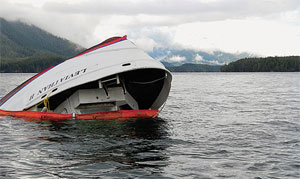Six people died when a 64-foot whale-watching boat with 27 people aboard capsized off the west coast of British Columbia’s Vancouver Island.
The accident involving Leviathan II, which had been converted from a crew boat into a whale-watching vessel in 1996, occurred Oct. 25 near the smaller Vargas Island. The bodies of five passengers, all Britons, were recovered at the scene. A sixth body, that of a 27-year-old Australian, was located Nov. 18.
The vessel had approached a rock near Plover Reefs on the west side of Vargas Island off the rugged coast of Vancouver Island to get a closer look at sea lions on the rocks when a large wave struck the boat, said Transportation Safety Board of Canada (TSB) spokeswoman Rox-Anne D’Aoust.
Most of the 27 passengers and crewmembers were on the top on the port side. The wave struck the vessel on the starboard side and the boat broached. With so many people on the top deck on the port side, the vessel’s center of gravity would have been raised, affecting stability, according to a statement from the TSB.
One life raft deployed and was activated, and at least two hand flares and one parachute rocket were fired.
Vessels in the area immediately responded from the communities of Tofino and Ahousaht.
Canadian Coast Guard (CCG) reports indicate that several calls around 1546 alerted them of the incident. Fisherman Clarence Smith, aboard a 21-foot boat, advised CCG that he had seen a flare and a boat on the rocks with a life raft in the water. CCG initiated emergency response measures and dispatched the CCG fast rescue craft Tofino 1.
Smith’s was the first vessel on the scene, rescuing two people in the water, one off the overturned vessel and 10 from the life raft. Other vessels from Tofino and Ahousaht recovered survivors and deceased passengers.
Coast Guard ships Cape Ann, Cape McKay and John P Tully, along with Department of Fisheries and Oceans vessel Dagger Point, were also tasked to the scene.
TSB investigators arrived Oct. 26 and met with the Royal Canadian Mounted Police to review the information that they were able to collect during and immediately after the rescue operation. They conducted interviews with the crew and some of the survivors to confirm facts during the time of the capsizing and coordinated efforts to salvage the vessel so that the team could access it and start the physical examination.
Investigators will continue to gather information and collect data in order to validate the information they have and to help determine the sequence of events leading up to the capsizing, the TSB said. Further, the team has identified a series of tests to be completed, and the vessel’s plotter will be examined at a laboratory.
As the investigation continues in the coming months, the agency said investigators will examine the vessel and verify stability information along with a TSB naval architect, review any modifications that have been made to the vessel, review regulatory requirements and history of inspections, and download and analyze the data contained in the recovered electronic equipment.
The TSB said it will continue interviews with survivors, witnesses, the company, Transport Canada and other people who could contribute important information. It will examine documentation from the Joint Rescue Coordination Centre concerning search-and-rescue response, examine lifesaving equipment on board and analyze environmental and meteorological data.
“Should the investigation team uncover safety deficiencies that present an immediate risk, the board will communicate them without delay so they may be addressed quickly,” the TSB wrote in a statement.
Leviathan II was built Crown Forest 72-112 by Rivtow Industries in 1981 and rebuilt into a whale-watching vessel in 1996. Based on an aluminum carvel/flush hull, it is 64.3 feet long, has a 15-foot beam and a draft of 5.25 feet. Powered by two diesel engines at 690 hp through twin screws, it is owned by Jamie’s Whaling Station.
Some news stories initially identified Leviathan II as a former tugboat. Lea Edgar, a librarian and archivist with the Vancouver Maritime Museum, said the consensus among naval architects she interviewed is that the vessel was nearly identical to a crew vessel, Miss Interfor, built as Crown Forest 72-113, a sister ship to Crown Forest 72-112.
“They were built one after the other the same year,” she said.
Transport Canada said that when the vessel was lengthened and an observation deck was added, a stability test of the vessel was conducted on July 25, 1996, by a qualified naval architect and witnessed by a Transport Canada inspector. The resulting stability book was found in compliance with the regulations and approved by Transport Canada.
In a statement, Corene Inouye, director of operations at Jamie’s Whaling Station, said that since 1982 the company’s sole focus has been to provide a safe and authentic West Coast experience to visitors from around the world.
“Aside from conducting regular safety drills and requiring stringent certification for our crew, we have also been diligent in ensuring the safety and seaworthiness of our vessels,” Inouye wrote, adding that “the Leviathan II was fully tested and certified by Transport Canada for stability and other safety aspects after its initial modification into a whale-watching vessel almost 20 years ago and has been inspected by officials every year since. Jamie’s would never have allowed a single passenger or anyone else to be on the water in a vessel that we were not absolutely confident was safe.”

